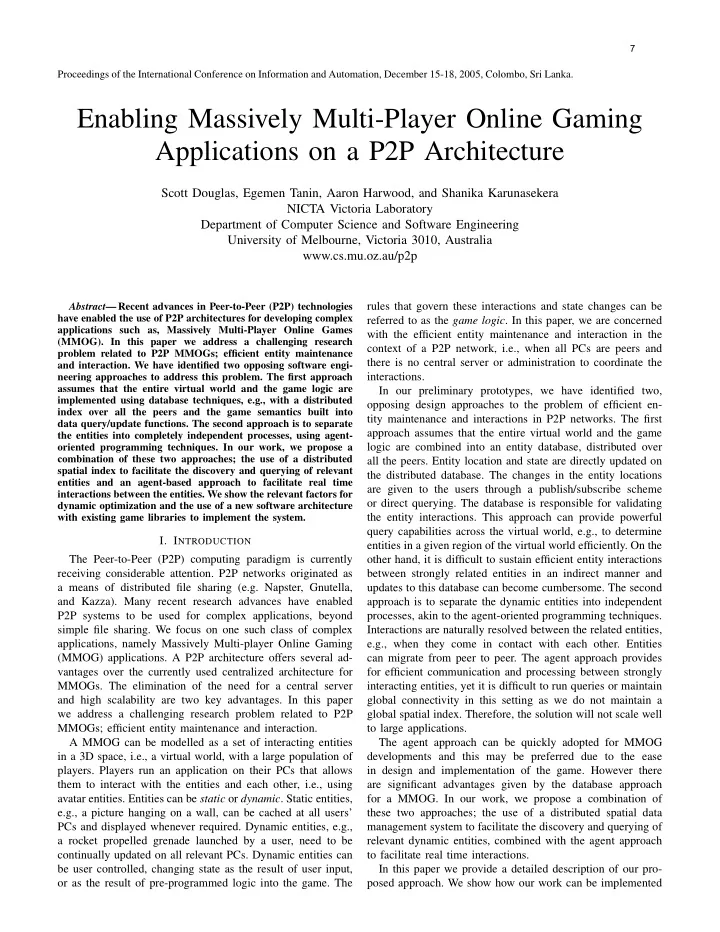

7 Proceedings of the International Conference on Information and Automation, December 15-18, 2005, Colombo, Sri Lanka. Enabling Massively Multi-Player Online Gaming Applications on a P2P Architecture Scott Douglas, Egemen Tanin, Aaron Harwood, and Shanika Karunasekera NICTA Victoria Laboratory Department of Computer Science and Software Engineering University of Melbourne, Victoria 3010, Australia www.cs.mu.oz.au/p2p rules that govern these interactions and state changes can be Abstract — Recent advances in Peer-to-Peer (P2P) technologies have enabled the use of P2P architectures for developing complex referred to as the game logic . In this paper, we are concerned applications such as, Massively Multi-Player Online Games with the efficient entity maintenance and interaction in the (MMOG). In this paper we address a challenging research context of a P2P network, i.e., when all PCs are peers and problem related to P2P MMOGs; efficient entity maintenance there is no central server or administration to coordinate the and interaction. We have identified two opposing software engi- neering approaches to address this problem. The first approach interactions. assumes that the entire virtual world and the game logic are In our preliminary prototypes, we have identified two, implemented using database techniques, e.g., with a distributed opposing design approaches to the problem of efficient en- index over all the peers and the game semantics built into tity maintenance and interactions in P2P networks. The first data query/update functions. The second approach is to separate approach assumes that the entire virtual world and the game the entities into completely independent processes, using agent- oriented programming techniques. In our work, we propose a logic are combined into an entity database, distributed over combination of these two approaches; the use of a distributed all the peers. Entity location and state are directly updated on spatial index to facilitate the discovery and querying of relevant the distributed database. The changes in the entity locations entities and an agent-based approach to facilitate real time are given to the users through a publish/subscribe scheme interactions between the entities. We show the relevant factors for or direct querying. The database is responsible for validating dynamic optimization and the use of a new software architecture the entity interactions. This approach can provide powerful with existing game libraries to implement the system. query capabilities across the virtual world, e.g., to determine I. I NTRODUCTION entities in a given region of the virtual world efficiently. On the The Peer-to-Peer (P2P) computing paradigm is currently other hand, it is difficult to sustain efficient entity interactions receiving considerable attention. P2P networks originated as between strongly related entities in an indirect manner and a means of distributed file sharing (e.g. Napster, Gnutella, updates to this database can become cumbersome. The second and Kazza). Many recent research advances have enabled approach is to separate the dynamic entities into independent P2P systems to be used for complex applications, beyond processes, akin to the agent-oriented programming techniques. simple file sharing. We focus on one such class of complex Interactions are naturally resolved between the related entities, applications, namely Massively Multi-player Online Gaming e.g., when they come in contact with each other. Entities (MMOG) applications. A P2P architecture offers several ad- can migrate from peer to peer. The agent approach provides vantages over the currently used centralized architecture for for efficient communication and processing between strongly MMOGs. The elimination of the need for a central server interacting entities, yet it is difficult to run queries or maintain and high scalability are two key advantages. In this paper global connectivity in this setting as we do not maintain a we address a challenging research problem related to P2P global spatial index. Therefore, the solution will not scale well MMOGs; efficient entity maintenance and interaction. to large applications. A MMOG can be modelled as a set of interacting entities The agent approach can be quickly adopted for MMOG in a 3D space, i.e., a virtual world, with a large population of developments and this may be preferred due to the ease players. Players run an application on their PCs that allows in design and implementation of the game. However there them to interact with the entities and each other, i.e., using are significant advantages given by the database approach avatar entities. Entities can be static or dynamic . Static entities, for a MMOG. In our work, we propose a combination of e.g., a picture hanging on a wall, can be cached at all users’ these two approaches; the use of a distributed spatial data PCs and displayed whenever required. Dynamic entities, e.g., management system to facilitate the discovery and querying of a rocket propelled grenade launched by a user, need to be relevant dynamic entities, combined with the agent approach continually updated on all relevant PCs. Dynamic entities can to facilitate real time interactions. be user controlled, changing state as the result of user input, In this paper we provide a detailed description of our pro- or as the result of pre-programmed logic into the game. The posed approach. We show how our work can be implemented
Recommend
More recommend